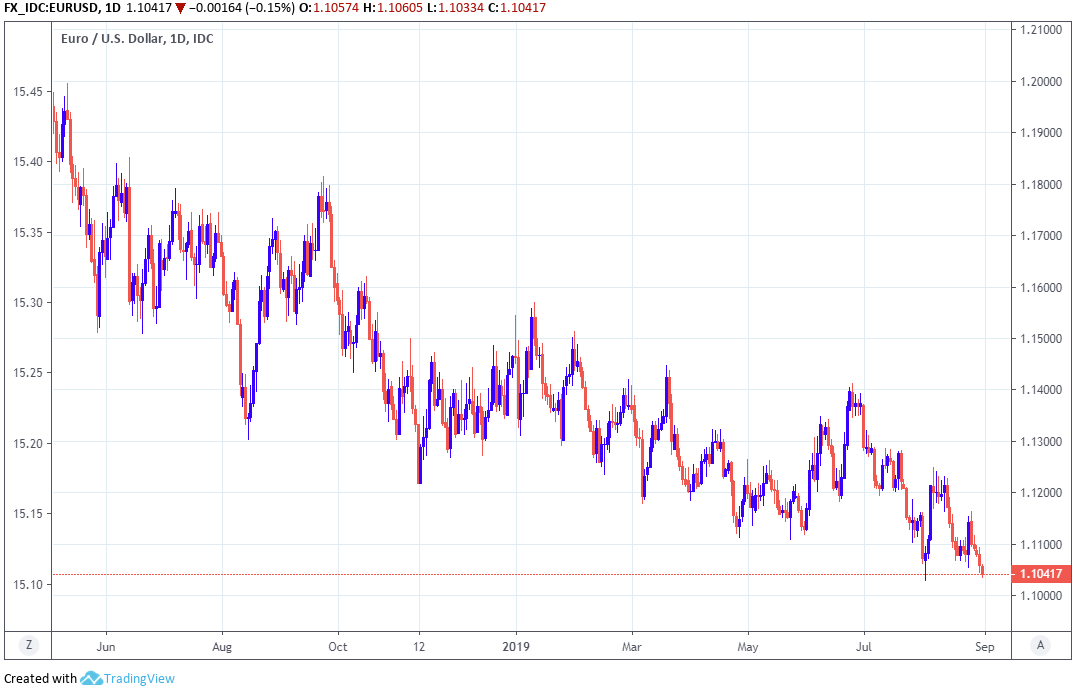The Euro-Dollar Charts Point Lower and a Recession in Germany "Just Moved One Step Closer"
- Written by: James Skinner
-

Image © European Union 2018 - European Parliament, Reproduced Under CC Licensing.
- EURUSD charts point lower as fundamental outlook hinges on ECB.
- EUR inflation holds at downwardly-revised levels, calls for the cavalry.
- Comes as retail sales slide in Germany, further raising risk of recession.
- Souring economy and rising external risks argue for ECB action in Sept.
The Euro slumped Friday but could fall even further over the coming weeks, according to technical analysts at Commerzbank, while Eurozone economic figures are increasingly seconding the signal coming from the charts.
Eurozone inflation held at just 1% in August, Eurostat figures showed Frdiay, unchanged from the downwardly-revised rate seen back in June although the agency had reported that previous figure as 1.1%. That was in line with expectations although core inflation, which is seen by the market as truer reflection of domestic price pressures, surprised on the downside.
The core number, which ignores volatile items like energy, food alcohol and tobacco because of the way their prices are influenced by artificial factors, held at 0.9% this month when markets had been looking for it to rise back to 1%. Both numbers are a country mile below the European Central Bank (ECB) target of "close to but below 2%" and have strengthened the case for policymakers to take action at the end of the central bank's next meeting September 12.
"Inflation was on the soft side for August," says Mark McCormick, head of FX strategy at TD Securities. "The trend there is still looking quite soft into the ECB meeting coming up in two weeks, supporting the need for further easing."
Markets care about inflation data because it, as well as the pace of growth in an economy, dictate the outlook for price pressure up ahead. That's exactly what central bankers are attempting to manipulate when they tinker with interest rates, which are the primary driver of exchange rates, with lower borrowing costs normally used as a tool to lift inflation by stimulating the economy.
"While core inflation has not moved out of the 1% range for quite some time now, drivers of inflation have not provided much reason for optimism about a quick core inflation recovery in the months ahead.," says Bert Colijn, an economist at ING. "These are the final readings the ECB will get before the important stimulus decision. Don’t expect the ECB to hold back."
Changes in interest rates are normally only made in response to movements in inflation, which is sensitive to growth, but impact currencies because of the push and pull influence they have over capital flows. Capital flows tend to move in the direction of the most advantageous or improving returns, with a threat of lower rates normally seeing investors driven out of and deterred away from a currency. Rising rates have the opposite effect.

Above: Euro-to-Dollar rate shown at daily intervals.
"Short EURUSD has been a great trade for patient carry traders who sell the rallies and don’t get too ambitious at periodic new lows. Every new low for the last year has quickly yielded to back-filling and no strong trending – this latest move lower may see similar price action if Fed activism picks up strongly (precisely because the US dollar continues to press higher – the USD being more in the driver’s seat than the Fed itself)," says John Hardy, chief FX strategist at Saxo Bank.
The Euro was 0.16% lower at 1.1041 against the Dollar Friday, and is now down almost 1% for the week and close to 4% for 2019, although analysts have differing views on the outlook for the single currency. Some say the interest rate winds coming from the U.S. could give it a boost in the short term while many are looking for the ECB to push the exchange rate lower in the weeks ahead. And others have eyes on an entirely separate set of factors.
"EUR/USD remains on course for the 1.1027 recent low and the base of its down channel at 1.0948. Below here lies the 78.6% retracement at 1.0814. Nearby resistance is the near term downtrend at 1.1166 and the 200 day moving-average at 1.1277, but key resistance is 1.1339/58, the 2018-2019 down channel and the 55 week moving-average. A weekly close above this latter level is needed for us to adopt an outright bullish stance," says Karen Jones, head of technical analysis at Commerzbank.
Above: Euro-to-Dollar rate shown at weekly intervals.
August's inflation data comes hours after Destatis said German retail sales fell by 2.2% in July, which was a far larger fall than the 1.3% market consensus had implied and is significant because it paints the domestic side of Europe's largest economy in a troubled light. Markets have assumed the domestic side of Germany's economy would counterbalance weakness coming from the external sector but Friday's data challenges that idea.
"Retail sales rose a cumulative 2.5% in Q1 and Q2, helping to sustain decent growth in consumers’ spending amid weakness in the rest of the economy. Now, however, we fear a setback," says Claus Vistesen, chief Eurozone economist at Pantheon Macroeconomics. "Our preliminary forecast that retail sales will fall some 1.5% quarter-on-quarter in Q3 point to downside risks for consumption. In short; the technical recession in Germany has just moved one step closer."
Friday's figures are just the latest in a growing line of dire numbers from Germany, whose manufacturing-intensive economy is being hurt by a cratering Chinese car market and a slowdown in global growth arising from the U.S.-China trade war. It's also exposed to the prospect of a 'no deal' Brexit.
Above: Pantheon Macroeconomics slide showing Eurozone and member growth rates.
German growth fell by 0.1% in the second quarter due to a steep reduction in exports, which fell 1.3% while imports declined by a lesser 0.3%, which economists attributed to the trade war. Those figures came hard on the heels of the August Ifo survey, which echoed the tone of ECB President Mario Draghi when he said in July the outlook for the economy is getting "worse and worse".
"The recent developments in the trade conflict not only suggest China has little intention to make big concessions to strike a trade deal, but also indicate that China has been preparing for a prolonged and broad-based conflict with the US," says Hao Zhou, an analyst at Commerzbank.
The Ifo institute said last week "there are ever more indications of a recession in Germany.". This was after its monthly survey of more than 7,000 companies showed current economic conditions falling to their lowest level since 2012 when represented in numerical format as an index. Companies also became more pessimistic in their outlook for the next six months, which is a similar message to that given off by the ZEW a fortnight earlier.
Above: ZEW six-month expectations index.
All of these factors, combined with already-low inflation, weakness elsewhere in Europe and an ongoing threat of further escalation in the U.S.-China tariff fight, are why the ECB is now widely expected to announce a significant stimulus package for the Eurozone economy on September 12. The bank hinted in July that it will cut rates next month and potentially restart the quantitative easing program that saw it buy almost a third of the European bond market between January 2015 and December 2018.
"Subdued Eurozone inflation pressures and unimpressive economic activity reinforces the case for more ECB easing. This is a headwind for EUR," says Elias Haddad, a strategist at Commonwealth Bank of Australia. "The ECB will cut the deposit rate by 10bps to ‑0.50% at its 12 September meeting. We also believe the ECB could introduce more TLTROs or a tiered deposit system on excess reserves to reduce the adverse effect of negative interest rates on Eurozone banks’ net interest income. Restarting asset purchases cannot be ruled out despite this week’s vocal objections by ECB policymakers Klaas Knot, Sabine Lautenschlaeger and Jens Weidmann."
At least one influential voice at the bank has already advocated strongly for a 'shock and awe' style stimulus package that goes far beyond current market expectations, although there have been reports suggesting others are opposed to further bond buying. The scale of the package, which would be designed to lift inflation by stimulating the economy with lower borrowing costs, is important for the Euro and Eurozone economic outlooks.
Above: Societe Generale graph showing Euro rising in trade-weighted terms, wih key EUR/CNY rate.
Rate cuts and quantitative easing might see 'yield' returns earned by investors in Eurozone financial assets further depressed at already-low levels, which would lead some investors to sell out of the Eurozone and could prompt others to bypass it altogether, which would lead to a weaker currency. A weaker Euro would be helpful to the ECB because it would lift inflation by raising the cost of imports while also making exports cheaper for other countries to buy. A stronger Euro would do the opposite.
Europe's single currency is down nearly 4% against the Dollar this year but it has risen in 'trade-weighted terms' and could strengthen further if the U.S. Federal Reserve (Fed) indulges President Donald Trump with rate cuts of its own that end up weakening the Dollar. This threat of currency appreciation puts the ECB in a position where it needs to run faster in order to simply stand still.
"The Chinese yuan is falling against the US dollar in tandem with tariff increases. The euro and dollar have gained nearly 5% since the end of Q1 and a move USD/CNY 7.5 would result in boost to the trade-weighted value of the euro and dollar by around 2% each," says Kit Juckes, chief FX strategist at Societe Generale. "The US economy can cope (though President Trump might be irked). The Eurozone economy is more sensitive to currency movements and in worse shape. Yuan depreciation will further delay a euro rebound, regardless of narrowing interest rate differentials and it will send the dollar higher overall."
Time to move your money? Get 3-5% more currency than your bank would offer by using the services of foreign exchange specialists at RationalFX. A specialist broker can deliver you an exchange rate closer to the real market rate, thereby saving you substantial quantities of currency. Find out more here. * Advertisement
